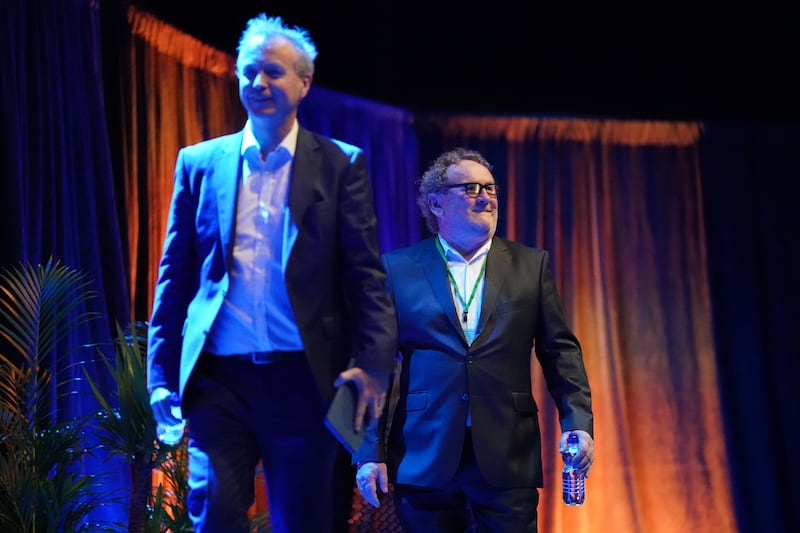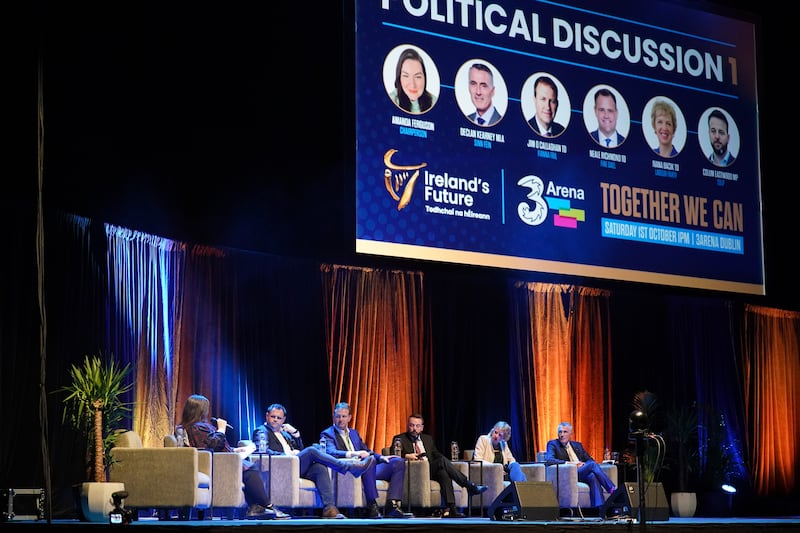The people behind Ireland’s Future, at pains to stress the non-political nature of their event (categorically not a rally but a conference), pointed to the impressive range of 10 Irish political parties represented at it.
One of them, perhaps not unsurprisingly, seemed far more represented than the others.
This made for one official party conference on the southside of the Liffey on Saturday and another, completely unofficial one, on the northside. Along with two official keynote speeches on the day and a bonus unofficial one.
In an unfortunate scheduling clash, Fianna Fáil’s annual ardfheis was taking place in the RDS with a keynote address from party leader Micheál Martin, while the Ireland’s Future conference was happening in the 3Arena with its I Can’t Believe It’s Not A Keynote Address address from the leader of Sinn Féin, Mary Lou McDonald.
High Court to hear challenge to accommodation for 1,000 asylum seekers in Athlone
Labour Party ‘unlikely’ to enter government but not out yet, says Bacik
Bill Tormey profile: Former Fine Gael politician a vocal commentator on health service for decades
Why FF and FG are not looking forward to potentially forming a government with Independents
It would have been easy to dismiss the Ireland’s Future extravaganza as an elaborate nationalist talking shop on how best to bring about the reunification of Ireland. In the run up to it, there wasn’t exactly a buzz around Dublin about the event and we heard no talk of it in the corridors of Leinster House, where minds were probably too focused on the budget.
The advance publicity predicted a big crowd for this “conversation” on the possibility and viability of “new constitutional arrangements” on the island and those numbers materialised, with the vast arena reconfigured for an afternoon conference audience of 5,000. “It’s a full house,” said a spokesperson for the non-profit, non-partisan, pro-unity, cross-community, cross-cultural campaign group, which advocates for and promotes discussion on a united Ireland.
Crowds milled around outside the docklands venue before the 1pm start. Three long queues snaked around the concourse to the front, side and back of the old building, their presence attracting a small number of campaigners from the anti-vax, anti-emigration, anti-whatever-you’re-havin’-yourself brigade of conspiracy theorists.
“Irish schools are not refugee camps ... Traitor Mary Lou ... Traitor Simon Coveney ... Raidió Teilifís Éireann (RTÉ) - we are awake to your lies!”
A man held a placard displaying pictures of Micheál Martin, Leo Varadkar and Eamon Ryan with the word “Quislings” written underneath. The protester standing next to him held up a sign saying “Our Freedom of Expression is Under Attack.”
Fleets of buses dropped audience members to the event. “I had Mitchel McLaughlin [retired SF general secretary] in the car yesterday,” said our taxi driver when he heard where we were headed. “That’s explains it now.”
Honest and insightful remarks from Neale Richmond, who would have been dismissed by many in the auditorium as a token West Brit, went down well
Standing in line, the overwhelming presence of Northern Irish accents was striking. “It’s like a queue to get into Garth Brooks, without the Stetsons,” joked an onlooker.
Apart from the politicians from the 10 different parties listed as speakers — two each for Fianna Fáil (Jim O’Callaghan and Senator Mark Daly), Sinn Féin (Mary Lou McDonald and Declan Kearney), Fine Gael (Tánaiste Leo Varadkar and Senator Neale Richmond), with one from each of the others, the only elected national representatives we recognised at the gig were from Sinn Féin. TDs and senators and local councillors, mostly, but not all Dublin based, mingled with friends while Pearse Doherty arrived later in the day. Former socialist Party TD Joe Higgins was in the audience.
Such was the size of the crowd the start had to be delayed.
The atmosphere in the arena was very upbeat and all age groups were represented in the audience. The number of young people giving up their Saturday afternoon to come and listen to three hours of speeches and panel discussion on “new constitutional arrangements” for a future Ireland was striking.
Following an evocative opening video with a sonorous voiceover by Liam Neeson (“Long before anyone can remember, there was a small island on the edge of the world ...”) and a sparkling Irish dancing performance from five young fellas in drainpipe trousers, MC for the afternoon and chair of Ireland’s Future, Senator Frances Black, introduced the first panel discussion. It featured Labour Party leader Ivana Bacik, SDLP leader Colum Eastwood, Fianna Fáil’s Jim O’Callaghan, Fine Gael senator Neale Richmond, and Sinn Féin MLA Declan Kearney, standing in for the indisposed Michelle O’Neill.
Kearney welcomed the conference as a “hugely significant landmark event”. He got a great reception from the crowd. Worries that the afternoon would turn into a Sinn Féin love-fest quickly dissipated as the subsequent exchanges proved thoughtful and thought provoking. The audience was attentive and engaged.
Honest and insightful remarks from Neale Richmond, who would have been dismissed by many in the auditorium as a token West Brit, went down well. He won people over with his comment about being on a panel with “people that I love to disagree with regularly, in a room filled with pretty much everyone I blocked on Twitter”.
There was much talk on preparing the ground carefully before any referendum, on listening, and learning.
There were no dissenting voices. Unionist politicians declined to attend, as did the Alliance Party.
Again, this should have reinforced charges that the event was no more than an echo chamber for nationalists. But the discussions were not about point-scoring. They were more reflective, exploring what it means now to be Irish on this island, no matter what your background might be.
Green Party senator Vincent P Martin, in contemplative mode, drew the nosiest, most negative response when he mused about the possibility of deleting “Republic of” from the name of a future, united island and replacing with “Ireland-Northern-Ireland”.
“It’s quicker, it’s easier on your tongue. It makes it more welcoming ...”
He was met by a rising crescendo of booing.
“I have no insecurities, I’m a proud constitutional republican and it’s time to be generous and reach out,” he countered, to another chorus of boos.

The actor Colm Meaney won vigorous applause when noting a change in public opinion on the Easter Rising. “This is one of the changes that’s happened over the years that I would not be a fan of — you know, to start talking about the leaders of 1916 as less than, you know, as I always saw them — freedom fighters.”
Tánaiste Leo Varadkar, in a well-judged speech, talked about Shared Island and cautioned against rushing into a referendum. He was briefly booed from one section of the crowd when he suggested continuing some ties to Britain in a united Ireland and received respectful applause when he finished. One suspected that the relatively muted reception was more to do with him being leader of Fine Gael than the actual content of his address.
There were compelling contributions from Baptist Minister, the Rev Karen Sethuraman, and communications consultant Ben Collins, both from a unionist background, on why they are now open to examining the possibility of a united Ireland.
The penultimate speaker of the afternoon was Sinn Féin leader Mary Lou McDonald, who was given a rapturous welcome, complete with standing ovation, by the crowd. When she walked onstage to deliver her speech, it felt like a keynote address evening at the party ardfheis. She got the same ecstatic response at the end of it.
Did the noise generated across the river ripple over the Fianna Fáil ardfheis, where another keynote address was delivered, where the crowd was smaller and the atmosphere, we hear, not quite as exhilarating?
To end with Mary Lou would have been a high for most people in the arena. But the official keynote address was still to come, so people stayed to hear actor Jimmy Nesbitt from Coleraine.
His speech was exceptional — inspiring, informative and entertaining. “I think we’re standing at a profound moment here in the history of the islands,” he said. “I would describe myself as an Irishman, from the north of Ireland, who in no way refutes nor shies away from my Protestant culture. But it does not define me and nor do I deny my Catholic friends their culture.
“I suppose to many from my background talk of a United Ireland is difficult, but the conversation is out there ... Let that voice emerge and let this opportunity not slip.”
Never mind the politicians, this was the keynote address of the night.






